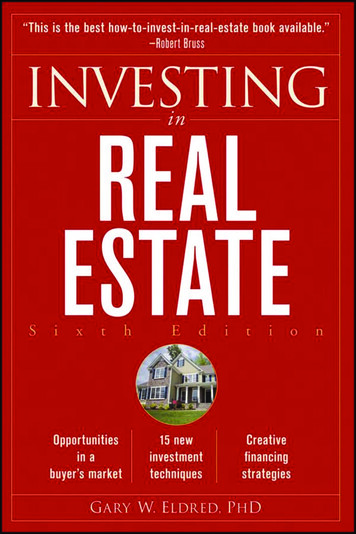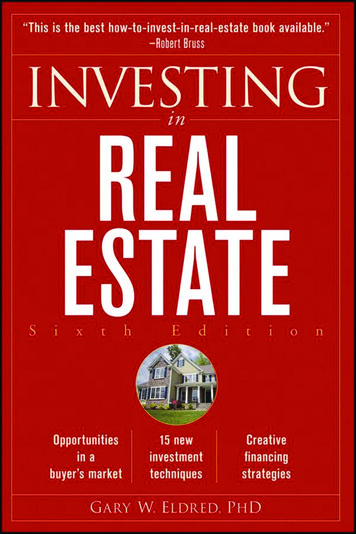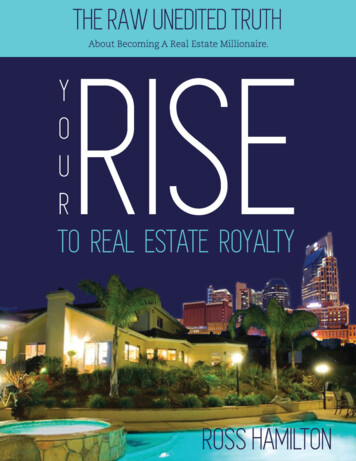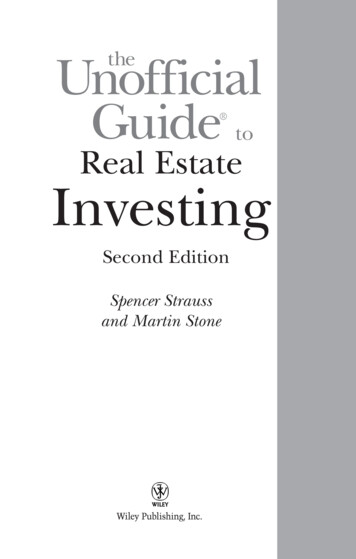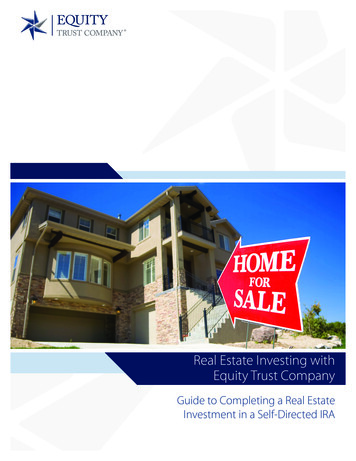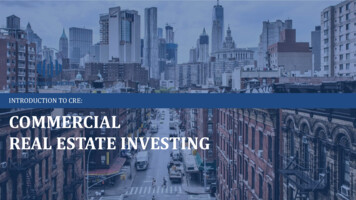
Transcription
INTRODUCTION TO CRE:COMMERCIALREAL ESTATE INVESTING
WHO ARE WE?Acuity Partners is a boutiqueinvestment firm offeringcommercial real estate andspecialty finance opportunitieswith a focus on preservation ofcapital, current income, and taxefficient capital appreciation.INTRODUCTION TO COMMERCIAL REALESTATE INVESTINGIntro to CRE is an essential primer on the world of commercial realestate investing, answering basic questions investors commonly have, aswell as furnishing key terms and definitions, for example: What is “net operating income”? Is there an easy way to determine my investment strategy?How does real estate compare to other asset classes?What is the difference between direct and indirect real estateinvesting?What are the benefits of investing in commercial real estate?2
THE BEST ASSET CLASSWhy Commercial Real Estate?Commercial real estate is one of the most dynamic investment classes in the world. Commercial real estateis the only major asset class that produces high yields, significant equity buildup, can be efficientlyleveraged for massive gains, has the security of a hard asset that you can see and touch (intrinsic valueregardless of an income stream), and provides some of the best tax advantages.REALESTATE“The major fortunesin America have beenmade in land.”- John D. RockefellerSTOCKSBONDSCASH &SAVINGSHIGH CASH RETURNEQUITY BUILDUPLEVERAGEHARD ASSET3TAX ADVANTAGE
One of the biggest advantages of commercial real estate is the high annual cash return that itproduces. In fact, commercial real estate income stream can produce three times the average stockdividend yield and four times the average bond yield. The chart below demonstrates the incomeeach asset class produces based on a 1 million investment.REAL ESTATE CAP RATESBOND YIELDSSTOCK YIELDSCap Rate: The cap rate is the net operating income divided by the purchase price.4
THE IMPORTANCE OF ASSET ALLOCATIONIt is recommended by leading experts that investors have ameaningful portion of their investment portfolio in alternativeinvestments, with a focus on commercial real estate. David Swenson,Chief Investment Officer of the Yale Endowment, a trustee ofTIAA-CREF (a Fortune 100 financial services organization), and theauthor of Unconventional Success:A Fundamental Approach to Personal Investment created what isknown as the Yale Model which has produced staggering returns ofnearly 14% annually, consistently outperforming the majoraverages. The portfolio has had up to 43% allocated to alternativessuch as real estate, venture capital, and private equity, with theincome producing real estate portion having exceeded 20%.“Asset allocation decisions play a central role indetermining investor results. Approximately 90% ofthe variability of returns stems from assetallocation, leaving approximately 10 percent of thevariability to be determined by security selectionand market timing. Careful investors play closeattention to determination of asset class targets.”- David Swenson, CIO of Yale Endowment5
A VERY SIMPLE INVESTMENT VEHICLETenants payrentBuilding expensesare paidTenants pay rent, usuallymonthly. Revenue can alsocome from parking, signage,etc.The property managerpays building expensesfrom the rental income.Investors are paidAfter expenses are paid, theremaining income isdistributed to investors.UPON SALE OF THE PROPERTY, EQUITY IS DISTRIBUTED BACK TOINVESTORS ALONG WITH ANY PROFITS FROM THE SALE.“If you don’t find a way to make money while you sleep, you will workuntil you die.”- Warren Buffett6
Real Estate’s Amazing LongTerm Income BenefitUnlike other asset classes, commercial realestate is typically leveraged with financing.Although stocks can be purchased on amargin account or commodities at a fractionof their price, but only commercial realestate provides rental income that coversdebt payments.This makes commercial real estate anoutstanding long-term investment classbecause as your tenants pay down thefinancing for you, equity is built up in theasset.Once the debt payments have been made,your cash return instantly increases,multiplying your cash flow multiple timesover.7
A PICTURE IS WORTH ATHOUSAND WORDS“Ninety percent of all millionaires become sothrough owning real estate. More money has beenmade in real estate than in all industrial investmentscombined. The wise young man or wage earner oftoday invests his money in real estate.”- Andrew Carnegie8
INCREASE EQUITY RETURN USING LEVERAGEReal estate allows for magnified equity buildup on a shorter-term basis by using financing,which is illustrated below. If you purchase a 10 million asset, all cash, and sell the asset inthe future at 11 million, you have made 1 million profit, or a 10% return.However, if you purchase a 10 million asset, utilizing only 1 million of your own moneyand financing the remaining (allowing the rental income to make the debt payments), then sell theasset, you have also made 1 million profit, however achieved a 100% return.9
REITS VS DIRECT REAL ESTATE OWNERSHIPInvesting in a Real Estate Investment Trust (REIT) is a popular way to “diversify” into real estate. However, wheninvesting in a REIT you do not actually own real estate, you own a share of stock in a company. The following are notableattributes of REIT investing:High FeesA private REIT can charge up to 17% up frontbefore your investment even touches the real estate. A recent REIT prospectus disclosed the following fees: 6.5% salescommissions, 3.5% dealer manager fee, 2.42% organization and offering expenses, 1.75% acquisition fees, and 0.96%acquisition expenses. For every 100 invested, less than 85 actually goes towards the real estate! Additionally, a REIT isonly required to distribute 90% of the income generated by its properties back to investors, significantly loweringoverall returns.Lower Average ReturnsThe average publicly traded REITdividend is 3.4%, significantly lower than average returns from direct commercial real estate ownership. Manyindividual properties can distribute an cash return ranging from 6% to 12% annually.High VolatilityGiven that REIT shares are stocks traded in the stockexchange, they are subject to the high volatility and market shifts of the stock market as a whole.Less TransparencyAlthough REITs have strict reporting guidelines, mostinvestors know very little about the properties in a REIT portfolio. Direct real estate ownership increases the overalltransparency of the investments.10
WHAT ASSET CLASS SHOULD I BUY?MULTI-FAMILY (Apartment Complex)As long as there are people, there is a need for housing. As the population grows, demand for housing increases aswell. Adjustments for inflation can be made annually through rental rate increases (except in rent controlled areas).The current generation prefers mobility and are not as apt to purchase a home or settle down,, therefore will continueto rentOFFICE BUILDINGSThe United States economy will continually be moving away from manufacturing and agriculture to a service focusedeconomy. The tech world thrives in offices and collaboration is key. More companies are opting to bring theirworkforce back into the offices versus letting them work from home (e.g. Yahoo).INDUSTRIAL BUILDINGSAs eCommerce continues to grow, so will demand for industrial distribution buildings. Amazon.com, Zappos, andother online retailers are joined by smaller businesses that will drive demand for industrial buildings.RETAIL PROPERTIESPeople will always have a need and desire to go to “bricks and mortar” retail establishments despite the advent ofeCommerce. There is a social and even therapeutic aspect to shopping that will never be replaced by online shopping.Generally, as the economy improves, the retail sector can see the increase in demand immediately.11
Demographic Trends Driving Multi-FamilyGrowthTrend #1:Trend #2:Trend #3:Baby Boomers are Flockingto Rental HousingLargest Demographic Flocksto Rental HousingU.S. Immigration Continuesto GrowThe U.S. home ownership rate is atits lowest level in 25 years and isexpected to go even lower. Rentergrowth is now at the highest level in30 years. Interestingly, families ormarried couples ages 45-64accounted for about twice the shareof renter growth as householdsunder age 35. This is according to astudy by the Joint Center forHousing Studies at HarvardUniversity.Millennials now top the BabyBoomers at about 73 million. Due topoor credit scores, many millennialscannot obtain a mortgage, and ifthey can, then tend to shy awayfrom increasing their debt. Rentingmakes it much easier for Millennialsto make ends meet every month,does not increase their debt, andallows them the flexibility of movingwhenever they choose.As a group, U.S. immigrants,regardless of socioeconomic status,rent more often than they own, andrent for longer periods of time.About 15% of Americans areforeign-born as of 2019, a numberthat has only continued to increasesince the 1970s.12
WHY ACUITY PARTNERS?Experience and Access to Deal Flow: Our founders met early in their Wall Street careers and reunited in 2016 to form AcuityPartners. We believe our 60 years of collective experience and the industry relationships we have built allows us the ability tosee a multitude of opportunities and vet them properly.Business Principals: We are dedicated to providing access to proprietary commercial real estate deals, which are all putthrough a strict due diligence process to determine if they meet our core principles: Consistency – We aim to deliver stable, current income and/or tax-efficient capital appreciation with low volatility over amedium to long term duration. Transparency – Our commitment to open communication is evident throughout the entire investment process. Depth of Knowledge – Due to the fact that we limit our investment scope to commercial real estate, we are able to dedicateall of our time and resources to becoming experts the asset class. Risk Control – The investments are in our hands and typically under our control. Our focus on superior risk adjusted returnsinvolves our ability to identify, measure, and manage risk.Diversification: Our goal is to provide you with the top-notch commercial real estate investments you need to diversify andstrengthen your portfolio. Portfolio diversity is important as 90% of the variability of investment returns stems from assetallocation. With all of the various investments available, choosing the best ones requires professional help. We diversify ourinvestments across various types of real estate and across geographies.We Listen: We are not interested in being a one-stop-shop for your investing needs and as a privately owned firm, we do nothave any “house” products we are forced to sell. We spend time getting to know you and your needs, objectives, risk tolerance,and goals. Only when our offerings match those needs do we move forward.13
KEY TERMSAbsorptionNet Operating IncomeCapitalization RateAbsorption is the way commercial real estateinvestors gauge tenant demand and ismeasured in square footage. Total absorptionis the total new square footage leased bytenants. For example, if a building had 20,000square feet of new leases in 2013, its totalabsorption is simply 20,000. The morerelevant metric to view is net absorptionwhich is the total new square footage leasedminus the total square footage of tenants thatno longer occupy their suites in a given timeperiod. If a building had 20,000 square feet ofnew leases in 2013 and 5,000 square feet oftenants leaving, its positive net absorption issimply 15,000 square feet. Absorption can bemeasured by building or by entire markets.The net operating income is the total rentalincome from all of the tenants, parking revenue,and other revenues minus operating expenses(taxes, insurance, management, maintenance,utilities). The net operating income is one of thefirst metrics and investor will review/verifybecause the cash return to investors is paidfrom the net operating income. Net operatingincome does not take into considerationfinancing nor does it include capitalimprovement costs.The cap rate is the percentage of funds youpaid for the building that comes back to youannually (not taking financing intoconsideration). As an example, if youpurchased a building for 1,000,000 thatreturned 60,000 annually, your cap rate issimply 6%. The calculation is NOI Price Cap Rate %Cash-on-Cash ReturnThe cash-on-cash return is the percentage offunds you invested in the building that comesback to you annually after making financingpayments. Your cash-on-cash return is oftenhigher than your cap rate if favorablefinancing is put in place.Contract RentContract rent is the current rent being paid bythe tenant according to their lease. Contractrents are measured by square footage incommercial real estate. For example, if anoffice tenant is paying 21,000 a year for1,000 square feet of space, their contract rentis 21.00 per square foot per year. Contractrents may also be quoted monthly.Market RentMarket rent is the rental rate that a specificlocation could achieve if it were available tolease today. Like the contract rent, market rentis quoted per square foot. Investors comparemarket rent to contract rent to see if there isan opportunity to increase rental rates once asuite becomes available.14
CALL OR EMAIL US TODAY212-652-2292info@acuitypartnersnyc.com
Investing in a Real Estate Investment Trust (REIT) is a popular way to “diversify” into real estate. However, when investing in a REIT you do not actually own real estate, you own a share of stock in a company. The following are notable attributes of REIT investing: High Fees A p
